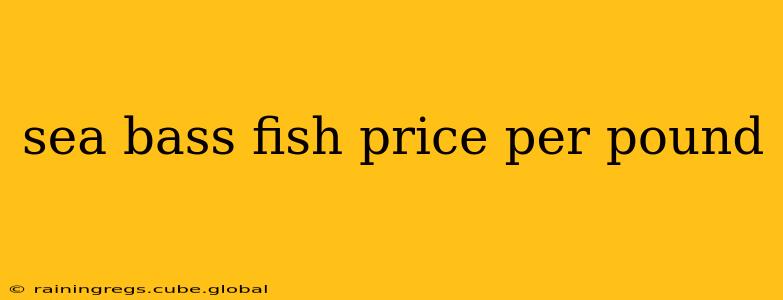The price of sea bass per pound can vary significantly depending on several factors. Understanding these factors will help you navigate the market and get the best value for your purchase. This guide will explore the price fluctuations, influencing factors, and provide you with tips for finding the best deals on this delicious fish.
What Factors Influence Sea Bass Prices?
Several key factors contribute to the fluctuating price of sea bass:
-
Species: There are many types of sea bass, each with its own taste and price point. European sea bass (also known as branzino) and Chilean sea bass (a misnomer, it's actually a Patagonian toothfish) are among the most popular, but their prices differ considerably. Chilean sea bass, often considered a luxury item, tends to command a higher price.
-
Seasonality: Like many other seafoods, sea bass prices are influenced by the season. Peak fishing seasons generally lead to more abundant supply and potentially lower prices. Conversely, out-of-season sea bass will usually be more expensive.
-
Location: Geographic location plays a vital role in pricing. The cost of transportation, local demand, and the availability of local fisheries all influence the final price you'll pay at your local market or restaurant. Coastal areas may have lower prices than inland locations.
-
Farming vs. Wild-Caught: Farmed sea bass generally costs less than wild-caught sea bass. Farming allows for greater control over supply, reducing the impact of seasonal fluctuations and environmental factors. However, some consumers prefer the taste and texture of wild-caught sea bass, and are willing to pay a premium for it.
-
Market Conditions: Overall market demand and supply significantly impact prices. Increased demand or reduced supply due to weather conditions or other unforeseen circumstances can drive prices up.
-
Retailer: Different retailers (grocery stores, fishmongers, online retailers) will have varying pricing structures due to their operational costs, sourcing strategies, and target markets.
How Much Does Sea Bass Typically Cost?
Giving a precise price per pound for sea bass is difficult due to the factors mentioned above. However, you can expect a range:
-
Farmed Sea Bass: Typically ranges from $8 to $15 per pound, depending on the retailer and location.
-
Wild-Caught Sea Bass (e.g., European Sea Bass): Can range from $12 to $25 per pound, or even higher, especially for larger, high-quality specimens.
-
Chilean Sea Bass (Patagonian Toothfish): Often priced between $25 and $40 per pound or more, reflecting its premium status.
Where Can I Find the Best Deals on Sea Bass?
To find the best deals, consider the following:
-
Shop around: Compare prices at different supermarkets, fishmongers, and specialty seafood stores.
-
Check for sales and discounts: Many retailers offer discounts on seafood, particularly during peak seasons.
-
Buy in bulk: Purchasing larger quantities can sometimes lead to lower per-pound prices.
-
Consider frozen options: Frozen sea bass is often a more budget-friendly alternative to fresh, while still maintaining good quality.
-
Look for sales and deals online: Many online retailers and grocery delivery services offer competitive pricing and special offers.
What are the Different Types of Sea Bass?
Several species are commonly referred to as "sea bass." Knowing the differences can help you understand the price variations:
-
European Sea Bass (Branzino): A popular choice known for its delicate flavor.
-
Chilean Sea Bass (Patagonian Toothfish): A richer, more luxurious option, often served in upscale restaurants.
-
Mediterranean Sea Bass: Another popular species found in the Mediterranean Sea.
-
Black Sea Bass: Common in the waters off the eastern coast of North America. It's often less expensive than other species.
Is Sea Bass Sustainable?
Sustainability is a growing concern for seafood consumers. When buying sea bass, look for certifications from organizations like the Marine Stewardship Council (MSC) to ensure responsible fishing practices. Farmed sea bass can also be a more sustainable choice depending on the farming methods used. Always check the source and inquire about sustainability practices.
This comprehensive guide should provide you with a better understanding of sea bass pricing and how to find the best value for your money. Remember that prices are subject to change, so always check with your local retailer for the most up-to-date information.
